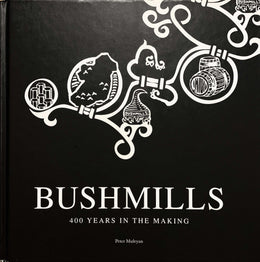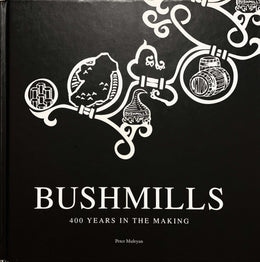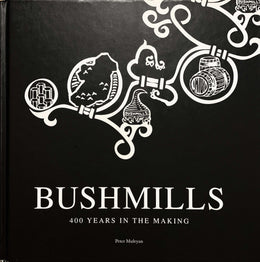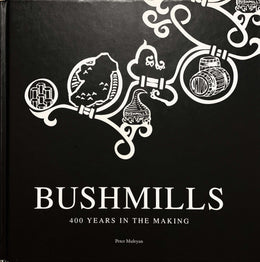
No1 maltings and the peat store which stood where the visitor car park is located, c1975
The creation of Ardbeg Distillery Ltd in January 1959 effectively took the distillery out of private control for the first time in its existence. Both The Distillers Company Ltd (DCL) and Hiram Walker Ltd substantially increased their share in the company, though the major shareholdings remained in private hands. Mr Hugh Cowan-Dougal, representing the Gray Buchanan's interests, and Mr Dan Lawson, representing his family, had seats on the board, along with figures from DCL and Hiram Walker.
A request by Messrs Churtons Ltd to bottle and sell old ‘Ardbeg’ at home and abroad was considered and agreed by the board, which noted "The label must be approved by us showing the word Ardbeg." It is unclear whether the bottling actually proceeded.
DCL placed an order for 700 casks to be filled each year for three years from 1960, which was a 200 per cent increase on their previous commitment. Despite this, just over 300,000 proof litres was produced in 1959, rising slowly to about 400,000 by 1964. With this vote of confidence by DCL and as part of an increasingly buoyant and expanding Scotch whisky industry, a modernisation programme was implemented in 1962 to increase the efficiency of the distillery. It was also decided to approach selected prospective new customers direct, "sending samples of old and new Ardbeg," rather than spend money on general advertising in monthly trade publications.
This is the first reference ever made to advertising and marketing Ardbeg whisky, though an element of financial caution is clearly evident. In the same year Mr Cowan-Dougal died, bringing to an end any direct involvement in the making of Ardbeg whisky by the Gray Buchanan family, which had financially backed Ardbeg from the outset in 1815. The following year, long time employee and distillery manager Dougie Maclntyre became ill, resulting in his taking early retirement after almost 50years of service at Ardbeg. Hamish Scott was subsequently appointed distillery manager in May 1964, taking up his post on 1 September 1964.
"I started work at Ardbeg soon after finishing my National Service," recalls Hamish. "Prior to my time there, Dougie Maclntyre was manager for around 12 years, and before that Hamish McMurchie (a Campbeltown man). He was there during the war years.

"I had begun in the whisky industry as a trainee at Aberfeldy distillery, where I worked for three years. Then I went to work in the SMD (Scottish Malt Distillers) Laboratory, at Coates Crescent in Edinburgh. After that I spent time at Ord distillery near Inverness as a temporary assistant, and then I was at Benromach.
"I then went out to Guyana and made rum for two years as the manager at the Diamond Distillery. They had Coffey stills made from wood, driven by steam. But at that time, the political climate in Guyana was changing, with independence, so I decided to come back to Scotland.
"I joined Scottish Grain Distillers, an offshoot of DCL, as they paid twice that of SMD in those days! I was brewer at Caledonian distillery in Edinburgh and at Cameronbridge in Fife. Then I was offered the manager's job at Ardbeg, and on a beautiful May day we flew over to see the distillery. I'd never been to Islay before. The place was sold for me that day.
"I was impressed with the size of the distillery. There were four malting floors working, but I soon became aware that not much money had been spent on the place. Dougie Maclntyre had even straightened out used nails to save the company money!"
The vast majority of Ardbeg spirit being made was used for blending purposes, as Hamish Scott notes "In 1964 we filled one 50 gallon cask per year for single malt. We were using old casks, so it was becoming very woody."
Hamish Scott's arrival coincided with an increasingly upbeat mood in the industry and as filling requests increased, production at Ardbeg was stepped up from six to eight mashes per week in 1965, and a new warehouse (number 10) was to be built at a cost of £34,310.
In any distillery which operated its own makings, a reliable source of peat was essential, and this was particularly important in a distillery such as Ardbeg, where the malt was heavily peated. In addition to his managerial duties, Hamish Scott became a founder of Islay Peat Developments, using mechanical peat-cutting equipment to harvest peat for Ardbeg and other Islay distilleries. According to Hamish "Even in the '60s it was difficult to find people willing to cut peat." Hamish also noted that "In my time, everything came in by puffer to the big pier at Ardbeg. Grain and coal. Quite a bit of spirit went out by puffer, and also on the Lochard, the MacBrayne's cargo boat."
1965 saw profits more than double that recorded in any of the previous six years, and the following year profits were even higher, principally due to a specially negotiated sales of much of the unwanted mature stocks of `Old Ardbeg' to DCL. By 1967 almost 700,000 proof litres were being produced, with the makings running close to capacity.
Ardbeg was clearly an attractive asset in a Scotch whisky industry that was beginning to be consolidated into the hands of a smaller number of large companies, and in 1969 the Canadian distilling giant Joseph E Seagram & Sons expressed an interest in buying the distillery, though nothing came of this approach. Virtually all of Seagram's Scotch whisky assets, held through its Chivas Brothers Ltd subsidiary, were situated on Speyside, so an Islay distillery would have provided them with a useful source of peated malt for blending purposes.
The strong focus of Ardbeg on the blending market (primarily through D C L and Hiram Walker) is illustrated by the fact that the Minutes of 21 December 1970 record "It was agreed that 1 case of Ardbeg (bottled) be allowed to the 3 Hotels on the Island each year at Christmas." Hamish Scott recalls "We had it bottled for us and it sold in local hotels."
"John Hopkin was the excise officer in my time. He was a Welshman, and had about 14 cats. A ginger one used to follow him into the office and sat there all day. He retired in 1975. He kept his dram in a Domestos bottle, so nobody knew what he had! Once a week or so he'd give me the warehouse keys and I went and got my share—about a gallon a week. And he would take the same. Locals would take him a lobster in return for a drop of it. But we had visitors to entertain, too. We didn't drink it all ourselves. And we were still dramming—the guys liked to drink the new spirit."
Hamish Scott
The following year yet another new warehouse (number 11) was constructed to cope with the high level of output being recorded. Fillings orders were favourable for the new distilling season, and it was proposed to reduce the silent season to just the middle of August. Increased production would mean buying in malt, so it was agreed to install new malt bins.
There are signs that the board of Ardbeg Distillery was beginning to consider bottled malt sales in a more serious way, and the Glasgow Bonding Co was approached regarding bottling Old Ardbeg in
1971, and in 1972 it was agreed that a start should be made to building up a stock of older whisky. In April 1972, a single malt was bottled and this appears to have been the first ‘commercial’ bottling of Ardbeg.
By the end of 1972, demand still outstripped supply and so consideration was given to outsourcing malt. It was agreed that not more than 12.5 per cent of bought malt could be used without altering the character of Ardbeg, and Hamish Scott was advised to proceed on this basis. Thus 1972 saw the last vintage of ‘peaty’ Ardbeg made using malt entirely produced in the on-site floor makings.
In 1973 Dan Lawson became company chairman. Although on the surface all was well at Ardbeg, with demand for the distillery's fillings being strong, behind the scenes there was a degree of ‘political’ posturing. The company Minutes for 23 November 1973 noted that "Both Mr McCann and Mr Murray [the Board representatives of Hiram Walker and DCL respectively] felt they had not been kept fully informed about the increased filling availability in time to take a decision about their own company requirements." They had also rejected a request from Chivas Bros to fill one hundred hogsheads the previous year. Ardbeg appears to have once again missed an opportunity to broaden its customer base and develop its markets.
The November Minutes also recorded that "As there is no cased ‘Ardbeg’ in bond it was decided that 4 clr Casks (Spring 63, Spring/Aut 64 and Spring 65) be removed to Glasgow for bottling at 80 proof—natural colouring." With expansion still in mind, it was subsequently agreed that "not more than 15 per cent of bought malt should be used in order to retain the existing characteristics of Ardbeg."
1974 saw production peak at 1.1 million litres of spirit, yet despite the apparent prosperity of Ardbeg, the trustees of the Gray Buchanan family intimated that some or all of their holdings of 14,000 shares might be offered for sale, foreshadowing the future direction the company was to take. Hiram Walker indicated they would be willing to buy at, £4 per share and DCL noted that they would also consider buying at this price.
Due to a difficulty in cutting peat during bad weather in 1973 delivery to the distillery had been very much reduced and as a result a less heavily peated whisky was produced in 1974.The additional production for 1974 had been achieved without undue trouble although the spirit distilled was considered "not satisfactory" due to a bad yield and the increased throughput.
Ardbeg appears to have once again missed an opportunity to broaden its customer base and develop its markets
The filling and selling of a single Ardbeg malt was once again discussed, and Gordon & MacPhail & Co was subsequently approached with a view to bottling, marketing and retailing Ardbeg malt whisky. An agreement was not reached with Gordon & MacPhail, and so an approach was made to Messrs JA Mitchell & Co Ltd of Campbeltown. It was noted that the distillery had negligible stock of well matured Ardbeg, "not filled into the best wood and would not give credit to the name Ardbeg. Mitchells at present hold stock of Ardbeg of ages 17 years and downwards and could obtain mature Ardbeg in sufficient quantities to make the operation viable." Interestingly, Ardbeg had just turn down a three year order from JA Mitchell to fill 30 casks, so relations were presumably none too cordial, and needless to say, nothing came of these discussions either.
Rather ominously, however, DCL indicated they would be reducing their fillings of Ardbeg in 1975, and Hiram Walker indicated they would possibly be willing to take this up, depending on the quantity. DCL did indeed reduce its fillings from 2,300 hogsheads to 1,000, (a drop of around 80,000 original proof gallons), in line with a cut back in production at its own distilleries, and as Hiram Walker did not take up the shortfall, Mr Scott was instructed to "cut back production immediately."
In the meantime "Mr Scott reported that the initial reaction to the Ardbeg bottled in July had been encouraging, but it was very difficult to asses what future demand might be. Of the 345 cases of Ardbeg bottled by Strathleven Bonded Warehouses in July, a total of 110 cases had been sold to date." The board agreed to continue bottling Ardbeg on a small scale. Speaking recently, Hamish Scott recalls "We bottled a ten-year-old and sold 90 cases at a catering and licensed trade exhibition in 1975. By the late 1960s we had been managing to get stock laid down, so that was what we were bottling. We got a lot of repeat business. Generally we were filling into ex-Bourbon casks, though DCL supplied Sherry butts and ‘hoggies’ for us to fill for them."
The seriousness of the downturn in business for Ardbeg was brought home when Hiram Walker reduced their filling order for 1976 to 60,000 from 165,000. On a slightly more positive note, an order for 50 cases of ‘Ardbeg’ was received that year from Groothandel Van Wees, Amersfoort, Holland, representing the first major export of bottled Ardbeg. "The chairman stated that bottled Ardbeg had always been available to shareholders and local hoteliers on Islay. To promote bottled Ardbeg would require intensive marketing effort and considerable finance to lay down stocks as the present stock of old Ardbeg was not adequate to bottle on a large scale."
The downturn in Ardbeg's fortunes led Major P Fletcher (nephew of Colin Hay and a relatively minor shareholder) to propose the sale of the private shares in Ardbeg to Hiram Walker. He cited an "imbalance" between the interests of the family and trade shareholders, perceiving the distillery to be at the mercy of DCL and Hiram. Walker's pricing policy. Major Fletcher had proposed in January of 1976 a "diversification of our customer range" and "the marketing of Ardbeg asa straight Islay Malt of specialist character," something nearby Laphroaig had effectively been doing for more than a century.
At this time, the Gray Buchanan family owned 14,000 shares, the Lawson family 6,200, the Hay (Fletcher) family 4,200, DCL 6,000 and Hiram Walker 6,800 shares. However, most of the Gray Buchanan shares were owned by a family trust. With substantial investment being needed in the distillery, despite the production increases of the 1960s and early '70s, Kathleen Lawson's stockbrokers considered Ardbeg "a very unmarketable asset." With this advice in mind, and as the ‘senior’ and largest private shareholder, Kathleen Lawson went along with Major Fletcher and supported the sale of the privately held shares.
Production for 1976 was just over 400,000 proof litres compared to over 1 million two years earlier, and it was recorded that "No further export orders of bottled Ardbeg had been received, otherwise sales remained steady. It was agreed not to bottle any more in the meantime." Signs that Ardbeg whisky was still a desirable commodity, however, came with a steady stream of individual orders and with the statement that "Under pressure from local traders Miniatures had been bottled for distribution and that sales to date had been. encouraging." During the last six months of 1976, a 70° proof bottling with a new label was planned and eventually released.
During the turmoil, Hiram Walker approached DCL early in 1976 with a view to purchasing its shares in the distillery. DCL initially declined, but after Hiram Walker acquired the 27,200 private shares in October for £8 each, giving them an 85 per cent stake in the company, DCL agreed to sell its remaining 15 per cent to Hiram Walker in December.
Former Hiram Walker master blender Robert Hicks offers a historical explanation for why Hiram Walker may have wanted to acquire Ardbeg. "Way back in 1936 Harry C Hatch, president of Hiram Walker, came over to Scotland to place an order with DCL for grain whisky. After being kept waiting for an hour and a half for his meeting he got up, walked out, went home and said ‘Nobody is going to do that to me again,’ and the company subsequently built the huge Dumbarton distillery two years later. From there Hiram Walker developed a policy of self reliance. This may well have been a deciding factor in their buying Ardbeg."

Mr Whyte from the Commercial Union Insurance Company with Hamish Scott in front of the company minibus


No1 kiln fire and the back of the kiln. Two families used to live in the house. When it was vacated, the top flat was turned into an office for the brewers, a small lab for nosing and sampling, and a spares store. The bottom flat was converted into toilets, showers and the first canteen for the workers. The lean to was used as a paint store. These building were demolished in 1977.

Written by Gavin D Smith & Graevie Wallace
The text is an excerpt from "Ardbeg: Heavenly Peated" (pp. 33 - 44), written by Gavin D Smith & Graevie Wallace, published 2018 by Hogback Publishing.







